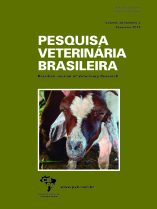 |
|
|
|
Year 2018 - Volume 38, Number 2
|

|
Tetanus in horses: an overview of 70 cases, 38(2):285-293
|
ABSTRACT.- Ribeiro M.G., Nardi Júnior G., Megid J., Franco M.M.J., Guerra S.T., Portilho F.V.R., Rodrigues S.A. & Paes A.C. 2018. Tetanus in horses: an overview of 70 cases. [Tétano em equinos: um panorama de 70 casos.] Pesquisa Veterinária Brasileira 38(2):285-293. Departamento de Higiene Veterinária e Saúde Pública, Faculdade de Medicina Veterinária e Zootecnia, Universidade Estadual Paulista “Júlio de Mesquita Filho”, Cx. Postal 560, Botucatu, SP 18618-681, Brazil. E-mail: mgribeiro@fmvz.unesp.br
Tetanus is characterized by high case fatality rates in horses. Comprehensive case series studies involving equine tetanus from different geographic areas enable the evaluation of prognosis, efficacy of treatment, and control measures. We retrospectively investigated some selected epidemiological data (breed, age, gender, use of the horses, history of vaccination, seasonality, presence of wound/history of surgical procedures, clinical outcomes) and main clinical aspects (clinical signs, incubation period, length of hospitalization, and period between onset signs and hospitalization) in 70 cases of equine tetanus over 1990-2015, with emphasis in the association between these data and the clinical outcomes. High mortality rate (72.9%) was observed in this study. Forty (57.1%) horses presented history of wounds or surgical procedures related with tetanus, represented mainly by lesions in the hind limbs (42.5%), front limbs (15.0%), umbilical infections (7.1%), castration (4.3%), and face wounds (4.3%). Hyperesthesia, limb spasticity, cervical stiffness, tetanic spasms, and restriction of jaw movement were the main consistent clinical signs. Besides no statistical association, all the horses with umbilical infections, wounds in face, prolonged recumbency, sweating, dysphagia/aphagia died, and together with delay between onset of first clinical signs and prompt veterinary assistance (< 5 days) were considered indicative of poor prognosis; whereas there was a significant association (p=0.001) between survival and length of hospitalization > 7 days, seemed as an evidence of good prognosis. The high mortality rate of tetanus, even in horses under specific treatment, highlight the need for early diagnosis, prompt veterinary assistance, and establishment of prophylatic measures in equine farms.
|
| |
|
|
| |
|
 |